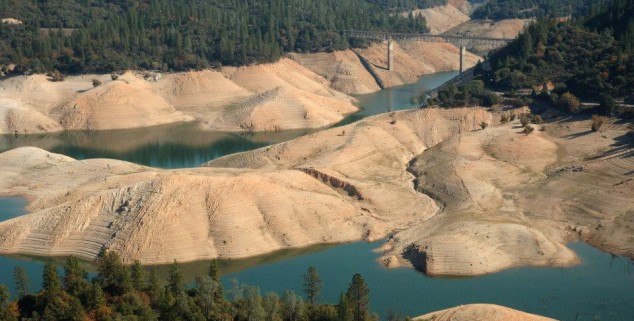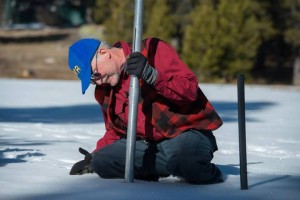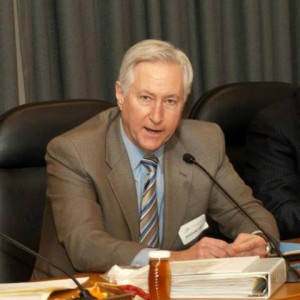News
Drought: The behemoths combine
 Lake Oroville ravaged by drought. (Photo: State Department of Water Resources, 2014)
Lake Oroville ravaged by drought. (Photo: State Department of Water Resources, 2014)The heavy hitters are stepping up to the plate.
California’s two behemoth water deliverers — the State Water Project and the federal Central Valley Project, perhaps the best known water purveyors in the world — are poised to join together to move water quickly around the state in the face of an unprecedented drought.
Gov. Brown’s decision to ask Californians to voluntarily reduce their water consumption by 20 percent received support, especially among those with long memories: In the historic drought of 1977, California had 22 million people. This year, it has at least 38 million.
“The big picture here the governor is calling for conservation,” said Ron Stork of the Friends of the River. “That’s not only a good thing, but an essential thing. Some conservation will be required, and when you conserve, you are building more reliability into your supply.”

DWR’s Frank Gehrke checks the Sierra snowpack. (Photo: DWR)
But the temporary consolidation of the two enormous water networks — 80 percent of Californians get at least some of their drinking water from the SWP and the CVP serves much of the farm belt — raised concerns and prompted discussions among water districts, environmentalists, farmers and lawmakers. The issue in the north is uncertainty about how the water would be distributed, whether environmental safeguards will be suspended and whether there would be a shift of priorities to move more water south. In the south it is equally basic: How much water will be available?
How ever the alliance plays out, the arrangement will be temporary.
“Those would be a change only during the duration of the drought,” said Nancy Vogel, a spokesperson for the state Department of Water Resources. The intent, she added, was “streamlining the whole bureaucracy” in the face of an unprecedented drought.
Gov. Brown said that the collaboration between the two projects would be defined by the State Water Resources Control Board, a panel of termed appointees of the governor headed by Chair Felicia Marcus. The governor asked the board, which has jurisdiction over “place of use” for both the state and federal projects, to consolidate their operations to “allow for transfers of water between the two systems without the State Water Board having to process a change petition for every single transfer.”
“There’s going to be a lot of barren ground,” Jason Peltier of the Westlands Water District, “at least 200,000 acres.”
The board could move on the governor’s consolidation request as early as this week. There is precedent for consolidation: It occurred during the Schwarzenegger administration in 2009.
According to Brown’s order, the board “will immediately consider petitions requesting consolidation of the places of use of the State Water Project and federal Central Valley Project, which would streamline water transfers and exchanges between water users within the areas of these two major water projects.”
“The consolidation of the place of use for the State and federal projects would allow for transfers of water between the two systems without the State Water Board having to process a change petition for every single transfer. An eligible transfer applicant would still be subject to DWR’s transfer approval process,” the order said.
Farms use an estimated four out of every five gallons of California water and face deep stresses when water is curtailed.
“There’s going to be a lot of barren ground,” Jason Peltier of the Westlands Water District, “at least 200,000 acres.” In the 2009 drought, his district none of its allocation, he said, and “the likelihood is that we’ll start this year with a zero allocation.”
Despite the complexity of consolidating operations and transferring water, the task certainly is doable, he added.
“It need not be a difficult thing to accomplish and my sense and is that the SWRCB (State Water Resources Control Board) is stepping up its game, not only in transfers but in all the operational limits. Those operational standards were all set with a range of water years of mind.” To some extent, he said, “this consolidation is going to require the regulatory agencies stepping back” but he said that “actions taken under the drought will be limited to the drought. Period.”

DWR Director Mark Cowin
The Central Valley Project, founded in 1933 during the Great Depression, was created primarily to help farmers. It moves about 7 million acre-feet of water annually; the SWP about 2.3 million acre-feet. Both use water from the north state, where most of the rain falls, and ship it southward, where most of the people are. Among farms, groundwater may account 40 percent of the water used, a figure that rises during times of drought when supplies from the projects dwindle.
” The governor’s challenge to each and every Californian to reduce water use sends the right message that we are one state and can never take water for granted,” he said.
While arid, the south state arguably has made better use of storage.
“Lowering water demand in Southern California is a big reason why this region has sufficient supplies short term, but this drought is a wakeup call to re-examine all of our water uses and redouble the commitment to conserve every possible drop,” said Jeffrey Kightlinger, general manager of the Metropolitan Water District of Southern California, a water wholesaler that serves 19 million people in 26 cities and water agencies across the south state.
” The governor’s challenge to each and every Californian to reduce water use sends the right message that we are one state and can never take water for granted,” he said.
Ultimately, the biggest concern in the governor’s may be the state’s food supply.
“My surface read is that it’s about agriculture,” said Kathryn Phillips of the Sierra Club. “My sense is that Southern California has done a pretty good job of water conservation. The kinds of things they’ve been talking about doing in SouthernCalifornia, how can we all share in improving our conservation and efficiency? This is just the beginning. This is the kind of thing we are going to face on a regular basis because of climate change.”
The drought “is not a north-south issue,” she added. “We have to make sure that every drop of water that is used is used conservatively.”
Gov. Brown, facing the second major drought of his political career and the worst dry spell in at least a century, signed the executive order Friday urging Californians to voluntarily cut their water use by 20 percent, and eased rules to enable farmers to purchase water from those with more plentiful supplies.
“A formal drought declaration signals that the state is prepared to channel resources and assistance to the areas in greatest stress this year, and paves the way for water transfers and other actions that can provide relief…”
“We are in an unprecedented, very serious situation,” the governor said at a San Francisco press conference. People should “pause and reflect on how dependent we are on rain and on mother nature.”
Brown, who during his first term as governor in the 1970s dealt with a then-unprecedented drought, said the politics of water was secondary to the need to deal with the problem.
With federal forecasters predicting a 90-day dry spell and with low levels at reservoirs across the state already dropping dramatically, the governor said the voluntary request could become a mandatory order if conservation goals are not met. Reservoirs have dropped below their historic lows and the Sierra Nevada snow pack, a critical indicator of spring runoff, is at only 20 percent of average.
“A formal drought declaration signals that the state is prepared to channel resources and assistance to the areas in greatest stress this year, and paves the way for water transfers and other actions that can provide relief,” said Timothy Quinn of the Association of California Water Agencies.
Brown, who during his first term as governor in the 1970s dealt with a then-unprecedented drought, said the politics of water was secondary to the need to deal with the problem.
“It’s a call to arms,” he added. “This is not a partisan adversary. This is mother nature.”
Environmentalists hope his “call to arms” doesn’t weaken environmental protections.
“The biggest concern I had, what alarmed me, was the notion of consolidated use,” Stork said.
“The fundamental question is what’s the intent? Is it to fundamentally change the CVP?” he said. “From the perspective of Northern California and a good deal of the state north of the Tehachapis, the notion has always been that the CVP has been to serve the Central Valley and not the MWD (Metropolitan Water District of Southern California).”
But the bottom-line issue isn’t about the bureaucracy.
“This is all about rain,” said Westlands’ Peltier.
Want to see more stories like this? Sign up for The Roundup, the free daily newsletter about California politics from the editors of Capitol Weekly. Stay up to date on the news you need to know.
Sign up below, then look for a confirmation email in your inbox.

This article failed to mention that the two agencies could not have cooperated very much until a couple of years ago when the Mendota Canal/California Aqueduct Intertie was built connecting the two systems. Now water transfers can occur between Federal water and State water. Before the intertie was built the two systems were about 500 feet apart but could not transfer water.
For years there was a counterpart problem at the Path 15 Intertie in the electrical grid between north and south California. A sort of extension cord connected the two fiefdoms of PG&E and Edison so during the California Energy Crisis of 2001 there was no way to transmit electrons from north to south and vice versa. Finally, Path 15 was upgraded. That still did not guarantee cross transmissions.
Creating a market for water transfers might help out the process. Just having the physical intertie doesn’t do the trick that markets can do. Water transfers between the Federal and State systems are complex because the bonds on the Federal Central Valley Project still have to be paid down with water sales. This article skipped over the bureaucratic aspects of how such water transfers might occur and who pays for the water.
Also, agriculture only uses 80 percent of the water in a very dry year IF they take their full allocation of water (which they are not). The State Dept. of Water Resources data indicates farmers use only about 40% of SYSTEM WATER in an average year and something like 20% in a wet year. About 50% of the water in the Federal Central Valley Project has been diverted to the environment since 1990 and just flows through rivers to the sea or the SF Bay but no new water storage reservoirs have been built to backfill that lost farm water. So the drought is man-made and well as nature-made.
If “[f]arms use an estimated four out of every five gallons of California water,”w hat percent of the farmland is factory farmed? And, what percent of the water bill do the factory farms pay?
If “[t]his is all about rain”, isn’t it common knowledge that most of our water comes from mountain forests, and that the healthier our forests are the more rain will fall, and the more rain in the mountains, the more water for the farms. The more our forests burn, esp., due to even age forestry, the less water there is.
Instead of fighting about who gets the water, why not make more water by improving the health of our forests which would make more jobs for forest dependent communities and more wood products for the economy?
If there is a drought, why are all the golf courses in San Diego still being watered, and why is the San Diego County Water Authority telling it’s member water agencies that it has plenty of water, no plans to ration or cut back water supplies and sees no need for more aggressive water conservation efforts?
[…] State Water Project and Central Valley Project to combine during drought: The Governor’s drought declaration allows the two projects to consolidate operations in order two streamline operations: ” … the temporary consolidation of the two enormous water networks — 80 percent of Californians get at least some of their drinking water from the SWP and the CVP serves much of the farm belt — raised concerns and prompted discussions among water districts, environmentalists, farmers and lawmakers. The issue in the north is uncertainty about how the water would be distributed, whether environmental safeguards will be suspended and whether there would be a shift of priorities to move more water south. In the south it is equally basic: How much water will be available? How ever the alliance plays out, the arrangement will be temporary. … “ Read more from Capitol Weekly here: Drought: The behemoths combine […]
[…] Drought: The behemoths combine […]
I am a small Business owner Fleet service we are opeator by powerwashing This situation with a water drought my business is not operating , Farmers are getting 100 milloin dollars for relief. I would like to know will my small business is there money. I have empolyee to pay there’s bills to be paid this drought can leave my company in a drought. Does any one out there know if there is Help for the small business owner. ????
instagram followers instantly
https://instagramfollowersfreequick.wordpress.com/free-instagram-followers-instantly/
free instagram followers fast
http://ow.ly/CBo7r